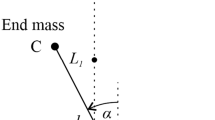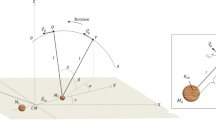Abstract
The paper focuses on the study and development of a mission to use the L1 libration point for deployment of a tether system in the direction of a moon in the planar elliptic restricted three-body problem on the example of the Mars-Phobos system. An orbiting spacecraft, which deploys the tether system, is located at the L1 libration point and is held at this point by the low thrust of its engines. The classical equations in the Nechville variables are converted into equations in polar coordinates. For the particular case when the tether is inextensible and two primaries moving in circular orbits about their mass center, these equations are integrated in quadrature, and the equilibrium positions and the oscillation period of the tether are found. As a result of eccentricity, the primaries move on ellipses around the barycenter, which rotates with angular velocity equal to that of the primaries, the position of the two-body pulsates along the axis connecting them. A new mission architecture is proposed, which includes three successive stages: initial deployment to the upper pulsation point (perigee), angular stabilization of the tether relative to the lower stable position, and maintaining a constant distance to a moon’s surface. An end mass with measuring equipment of this tether system can be set directly on the moon’s surface. Numerical simulations have shown the effectiveness of the proposed control laws of the tether system at all stages of the mission for the Mars-Phobos system, in which the L1 libration point is located quite close to the Phobos’ surface (~ 3.4 km). This paper is the first effort, using to justify publicly the possibility of implementing a mission with a tether system “attached” at L1 libration point to study surface of moons based on the proposed control laws and the sequence of their application. The results of this study can be used to enable many future missions throughout the solar system. If in the future similar missions will be approved, then undoubtedly more advanced control methods of this kind of systems will be developed.










Similar content being viewed by others
Data availability statement
The datasets generated during and/or analyzed during the current study are available from the corresponding author on reasonable request.
References
Beletsky, V.V., Levin, E.V.: Dynamics of Space Tether Systems. Univelt Incorporated, San Diego (1993)
Levin, E.M.: Dynamic Analysis of Space Tether Missions. Univelt Incorporated, San Diego (2007)
Troger, H., Alpatov, A.P., Beletsky, V.V., Dranovskii, V.I., Khoroshilov, V.S., Pirozhenko, A.V., Zakrzhevskii, A.E.: Dynamics of Tethered Space Systems. CRC Press, New York (2010)
Aslanov, V.S., Ledkov, A.S.: Dynamics of Tethered Satellite Systems. Woodhead Publishing, Cambridge (2012)
Williams, P., Hyslop, A., Stelzer, M., Kruijff, M.: YES2 optimal trajectories in presence of eccentricity and aerodynamic drag. Acta Astronaut. 64(7), 745–769 (2009). https://doi.org/10.1016/j.actaastro.2008.11.007
Williams, P., Blanksby, C., Trivailo, P.: Tethered planetary capture maneuvers. J. Spacecr. Rocket. 41(4), 603–613 (2004). https://doi.org/10.2514/1.1024
Jung, W., Mazzoleni, A.P., Chung, J.: Nonlinear dynamic analysis of a three-body tethered satellite system with deployment/retrieval. Nonlinear Dyn 82, 1127–1144 (2015). https://doi.org/10.1007/s11071-015-2221-z
Huang, P., Zhang, F., Chen, L., et al.: A review of space tether in new applications. Nonlinear Dyn 94, 1–19 (2018). https://doi.org/10.1007/s11071-018-4389-5
Yu, B.S., Xu, S.D., Jin, D.P.: Chaos in a tethered satellite system induced by atmospheric drag and Earth’s oblateness. Nonlinear Dyn 101, 1233–1244 (2020). https://doi.org/10.1007/s11071-020-05844-8
Ledkov, A., Aslanov, V.: Evolution of space tethered system’s orbit during space debris towing taking into account the atmosphere influence. Nonlinear Dyn 96, 2211–2223 (2019). https://doi.org/10.1007/s11071-019-04918-6
Kumar, K.D., Kumar, K.: Attitude maneuver of dual tethered satellite platforms through tether offset change. J. Spacecr. Rocket. 38(2), 237–242 (2001). https://doi.org/10.2514/2.3676
Kumar, K., Yasaka, T.: Rotation formation flying of three satellites using tethers. J. Spacecr. Rocket. 41(6), 973–985 (2004). https://doi.org/10.2514/1.14251
Cartmell, M.P., McKenzie, D.J.: A review of space tether research. Prog. Aerosp. Sci. 44(1), 1–21 (2008). https://doi.org/10.1016/j.paerosci.2007.08.002
Mashayekhi, M.J., Misra, A.K.: Optimization of tether-assisted asteroid deflection. J. Guid. Control. Dyn. 37(3), 898–906 (2014). https://doi.org/10.2514/1.60176
Aslanov, V.S., Ledkov, A.S., Misra, A.K., Guerman, A.D.: Dynamics of space elevator after tether rupture. J. Guid. Control. Dyn. 36(4), 986–992 (2013). https://doi.org/10.2514/1.59378
Kempton, K., Pearson, J., Levin, E., Carroll, J., Amzajerdian, F.: Phase 1 Study for the Phobos L1 Operational Tether Experiment (PHLOTE). End Report, NASA, pp.1–91. https://ntrs.nasa.gov/search.jsp?R=20190000916 (2018).
Sun, G., Zhu, Z.: Fractional-order tension control law for deployment of space tether system. J. Guid. Control. Dyn. 37(6), 2057–2167 (2014). https://doi.org/10.2514/1.G000496
Yu, B., Jin, D., Wen, H.: Nonlinear dynamics of flexible tethered satellite system subject to space environment. Appl. Math. Mech. Engl. Ed. 37, 485–500 (2016). https://doi.org/10.1007/s10483-016-2049-9
Szebehely, V.: The Restricted Problem of Three Bodies. Academic Press Inc., New York (1967)
Luo, T., Pucacco, G., Xu, M.: Lissajous and halo orbits in the restricted three-body problem by normalization method. Nonlinear Dyn 101, 2629–2644 (2020). https://doi.org/10.1007/s11071-020-05875-1
Zotos, E.E.: Classifying orbits in the restricted three-body problem. Nonlinear Dyn 82, 1233–1250 (2015). https://doi.org/10.1007/s11071-015-2229-4
Ferrari, F., Lavagna, M.: Periodic motion around libration points in the elliptic restricted three-body problem. Nonlinear Dyn 93, 453–462 (2018). https://doi.org/10.1007/s11071-018-4203-4
Woo, P., Misra, A.K.: Equilibrium points in the full three-body problem. Acta Astronaut. 99, 158–165 (2014). https://doi.org/10.1016/j.actaastro.2014.02.019
Biggs, J.D., Negri, A.: Orbit-attitude control in a circular restricted three-body problem using distributed reflectivity devices. J. Guid. Control. Dyn. 42(12), 2712–2721 (2019). https://doi.org/10.2514/1.G004493
Alessi, E.M., Sánchez, J.P.: Semi-analytical approach for distant encounters in the spatial circular restricted three-body problem. J. Guid. Control. Dyn. 39(2), 351–359 (2016). https://doi.org/10.2514/1.G001237
Markeev, A.P.: Libration Points in Celestial Mechanics and Astrodynamics. Nauka, Moscow (1978).. (in Russian)
Aslanov, V.S.: Stability of a pendulum with a moving mass: the averaging method. J. Sound Vib. 445, 261–269 (2019). https://doi.org/10.1016/j.jsv.2019.01.021
Acknowledgements
This study was supported by the Russian Science Foundation (Project No. 19-19-00085).
Author information
Authors and Affiliations
Corresponding author
Ethics declarations
Conflict of interest
The author declares that he has no conflict of interest.
Additional information
Publisher's Note
Springer Nature remains neutral with regard to jurisdictional claims in published maps and institutional affiliations.
Rights and permissions
About this article
Cite this article
Aslanov, V.S. Prospects of a tether system deployed at the L1 libration point. Nonlinear Dyn 106, 2021–2033 (2021). https://doi.org/10.1007/s11071-021-06884-4
Received:
Accepted:
Published:
Issue Date:
DOI: https://doi.org/10.1007/s11071-021-06884-4




